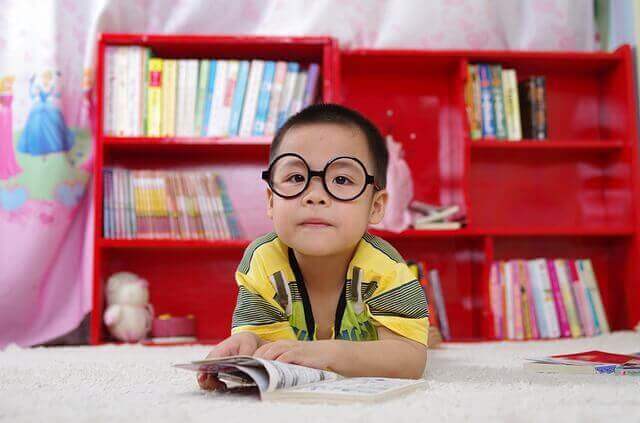How to Know if Your Child Needs Glasses

Just like adults, children perceive 80% of their surroundings through sight. Having good vision is crucial for their development and learning, and knowing if your child needs glasses is really important.
Fortunately, little ones don’t normally need glasses because they have excellent sight. However, there are of course exceptions.
Around 1 in every 5 school-age children suffers from some form of sight problem. Myopia, hyperopia, and strabismus are usually the most common sight-related problems.
Furthermore, parents need to know how to detect if their child needs glasses early on. Your child may not be aware that he has a problem. If he’s very young, he may not be able to clearly communicate what problems he’s having.
First months of life
We mentioned earlier that young children often have excellent vision, but that’s not entirely true. During the first weeks of life, most babies are farsighted. This is due to the size of the eyeball, which obviously later grows bigger, and the problem goes away.
However, if hyperopia continues or there is another problem, you need to detect it as early as possible. Premature children or children born weighing less than 3.5 lbs have a greater risk of developing sight problems.
As a result, ophthalmologists recommend an eye exam during the first 12 months of a baby’s life.

Possible signs that your child needs glasses
Even if you’ve already had an eye exam done, you should think about going back to a professional if you notice any of these symptoms:
- Frequently closing eyes, winking, or rubbing eyes.
- Squinting to focus.
- Reading with the book or computer screen very close to the face.
- Gets lost when reading or has to use a finger to follow words.
- Tilting head back or to the side to look at things.
- Regularly suffering from dizziness, nausea, or headaches.
- Having irritated eyes after school or at the end of the day.
- A lack of interest in outdoor games (because they can’t see well).
What are the most common problems?
Myopia
This is also known as short-sightedness. It’s caused when the eyeball is slightly bigger than normal, allowing you to focus on things which are near but not things which are further away. Anything in the distance looks blurry when the image is formed in front of the retina.
Once this condition appears, it tends to progressively get worse. The good news is that you can get glasses to correct this problem easily.
Hyperopia
This is the opposite of myopia and is also known as farsightedness. The eye is too small and this causes close images to be focused behind the retina, making them blurry. Mild cases usually disappear before the age of 10 years old without needing glasses.
Astigmatism
This occurs when the curvature of the cornea is irregular, causing slightly distorted vision with a mix of clear and blurry areas.
It’s normally a birth defect and doesn’t get worse over time. If it’s only mild and doesn’t cause eyestrain or headaches, then glasses aren’t necessary.
Lazy eye
This happens when the brain detects that the two eyes are seeing different images that don’t fit together. The brain then systematically ignores the information that it receives from one of the eyes.
This can happen for two reasons. One reason is that one eye suffers from one of the previously mentioned problems more than the other eye.
The other possible reason is that there is a muscular coordination problem with the eyes, such as strabismus or a deviation. This can lead to serious vision problems in the future and even a loss of binocular vision.

And if in the end there is no other choice but to wear glasses?
If you’ve visited your doctor and they’ve decided that your child needs to wear glasses, you need to be careful with how you introduce them to your child.
Your child shouldn’t view them as something negative. He should see them as a cool accessory, even something magical, that allows him to see things he couldn’t see before.
To make it easier for your child to accept glasses, you should give him the chance to choose his own frames. As for lenses, choose ones which suit his lifestyle and don’t shatter as soon as they get hit. Most specialists recommend organic lenses.
It might also be a good idea to get glasses with silicon earpieces to stop them from getting stuck if your child suffers a knock.
Just like adults, children perceive 80% of their surroundings through sight. Having good vision is crucial for their development and learning, and knowing if your child needs glasses is really important.
Fortunately, little ones don’t normally need glasses because they have excellent sight. However, there are of course exceptions.
Around 1 in every 5 school-age children suffers from some form of sight problem. Myopia, hyperopia, and strabismus are usually the most common sight-related problems.
Furthermore, parents need to know how to detect if their child needs glasses early on. Your child may not be aware that he has a problem. If he’s very young, he may not be able to clearly communicate what problems he’s having.
First months of life
We mentioned earlier that young children often have excellent vision, but that’s not entirely true. During the first weeks of life, most babies are farsighted. This is due to the size of the eyeball, which obviously later grows bigger, and the problem goes away.
However, if hyperopia continues or there is another problem, you need to detect it as early as possible. Premature children or children born weighing less than 3.5 lbs have a greater risk of developing sight problems.
As a result, ophthalmologists recommend an eye exam during the first 12 months of a baby’s life.

Possible signs that your child needs glasses
Even if you’ve already had an eye exam done, you should think about going back to a professional if you notice any of these symptoms:
- Frequently closing eyes, winking, or rubbing eyes.
- Squinting to focus.
- Reading with the book or computer screen very close to the face.
- Gets lost when reading or has to use a finger to follow words.
- Tilting head back or to the side to look at things.
- Regularly suffering from dizziness, nausea, or headaches.
- Having irritated eyes after school or at the end of the day.
- A lack of interest in outdoor games (because they can’t see well).
What are the most common problems?
Myopia
This is also known as short-sightedness. It’s caused when the eyeball is slightly bigger than normal, allowing you to focus on things which are near but not things which are further away. Anything in the distance looks blurry when the image is formed in front of the retina.
Once this condition appears, it tends to progressively get worse. The good news is that you can get glasses to correct this problem easily.
Hyperopia
This is the opposite of myopia and is also known as farsightedness. The eye is too small and this causes close images to be focused behind the retina, making them blurry. Mild cases usually disappear before the age of 10 years old without needing glasses.
Astigmatism
This occurs when the curvature of the cornea is irregular, causing slightly distorted vision with a mix of clear and blurry areas.
It’s normally a birth defect and doesn’t get worse over time. If it’s only mild and doesn’t cause eyestrain or headaches, then glasses aren’t necessary.
Lazy eye
This happens when the brain detects that the two eyes are seeing different images that don’t fit together. The brain then systematically ignores the information that it receives from one of the eyes.
This can happen for two reasons. One reason is that one eye suffers from one of the previously mentioned problems more than the other eye.
The other possible reason is that there is a muscular coordination problem with the eyes, such as strabismus or a deviation. This can lead to serious vision problems in the future and even a loss of binocular vision.

And if in the end there is no other choice but to wear glasses?
If you’ve visited your doctor and they’ve decided that your child needs to wear glasses, you need to be careful with how you introduce them to your child.
Your child shouldn’t view them as something negative. He should see them as a cool accessory, even something magical, that allows him to see things he couldn’t see before.
To make it easier for your child to accept glasses, you should give him the chance to choose his own frames. As for lenses, choose ones which suit his lifestyle and don’t shatter as soon as they get hit. Most specialists recommend organic lenses.
It might also be a good idea to get glasses with silicon earpieces to stop them from getting stuck if your child suffers a knock.
This text is provided for informational purposes only and does not replace consultation with a professional. If in doubt, consult your specialist.








